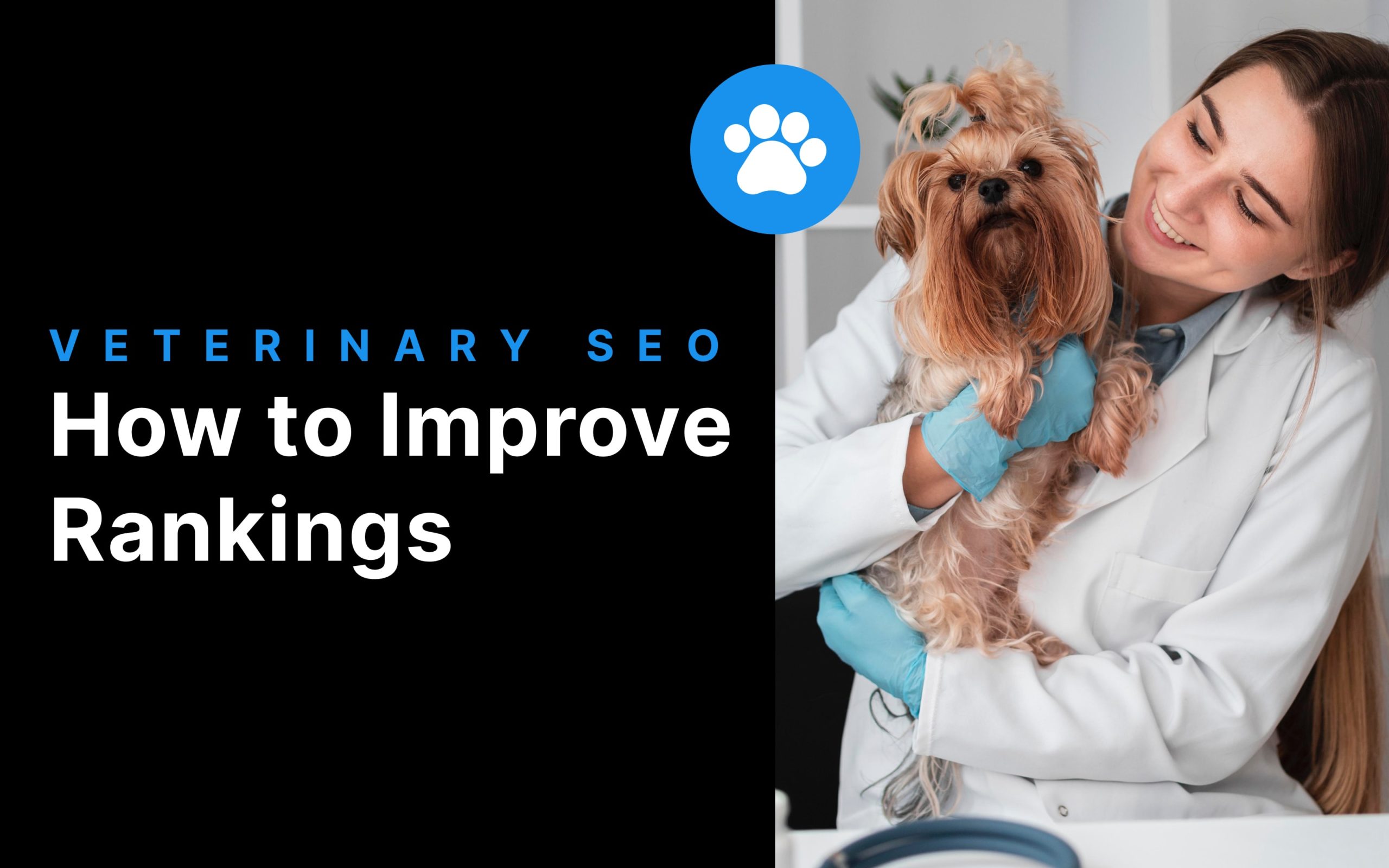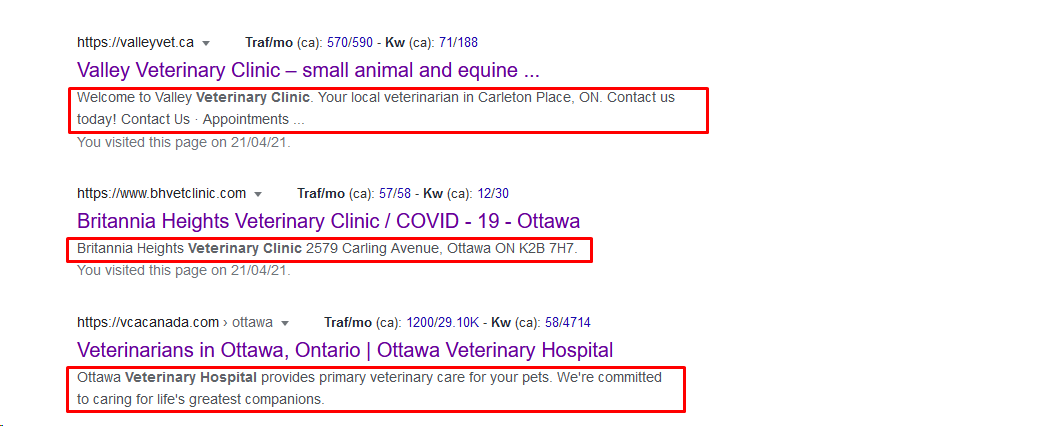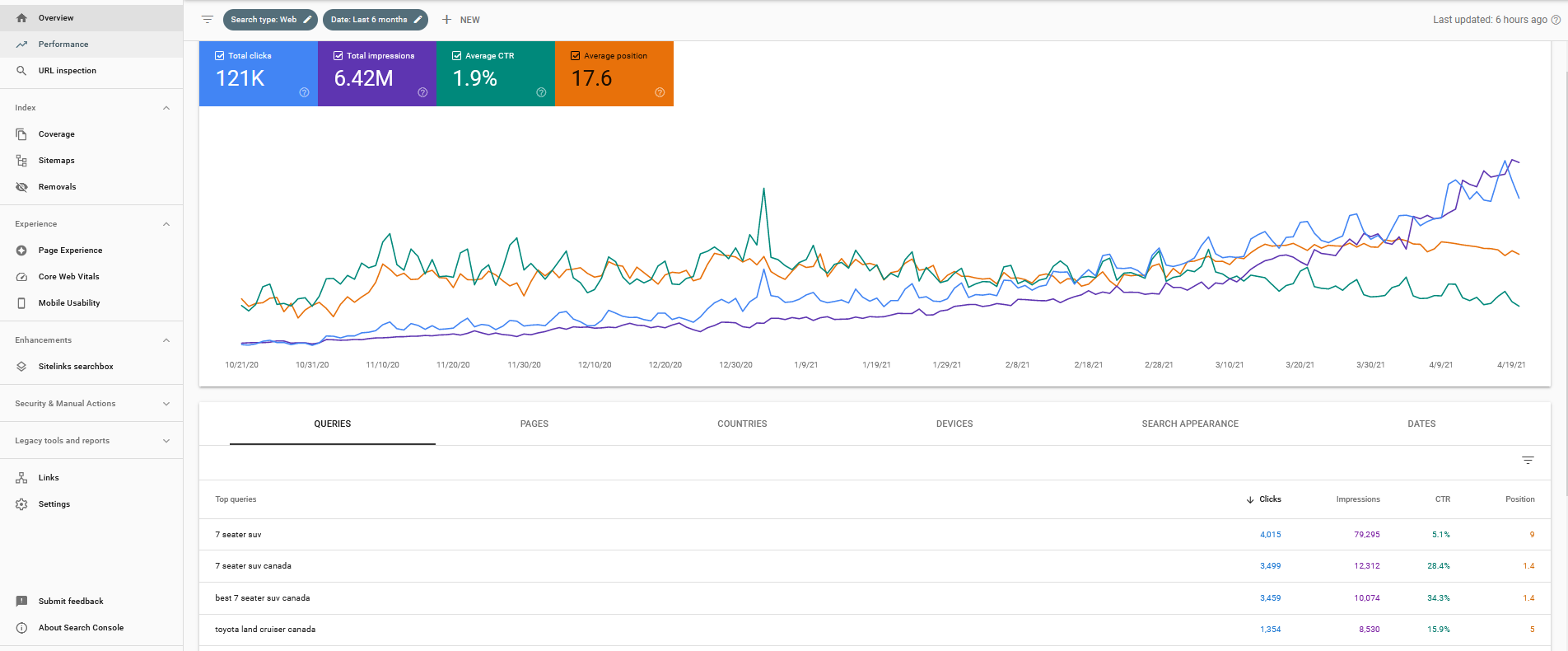
Obtaining new clients for your veterinary clinic is not like it was 10 years ago.
Let’s face it, newspapers and billboards aren’t the best method of advertising small businesses like yours in 2021.
With stay at home orders and digital acceleration in place, we’re all using the internet to search for what we want and what we need: it’s time to adapt.
But how can your veterinary clinic succeed in a digital setting? How can you improve your clinic’s Google Rankings in 2021? Here’s the short answer: Veterinary SEO.
What is Veterinary SEO?
Veterinary SEO, short for veterinary search engine optimization is the digital marketing strategy which focuses on optimizing veterinary websites and their presence to obtain increased search visibility on search engines like Google and Bing.With search engine optimization, your clinic can climb the ranks on Google and obtain a steady flow of organic search traffic.
As a result, you’ll get more clients and generate more revenue for your business.
Why SEO is Important for Your Veterinary Clinic
More than ever, pet owners are searching online for veterinary care.
They turn on their phones, tablets and computers and use search engines like Google and search for “veterinarian near me” or are seeking for information like “dog vaccinations ontario”.
Then, they read through the search results, and choose one that meets their needs. This means if you want those searchers to bring their pets to your veterinary clinic, you need to ensure that you rank well for the keywords they’re searching.
What’s also important is your business’s online reviews. They play a significant role in the decisions of search engines and consumers on whether or not your business is trustworthy.
So you’ll want your business to rank for these keywords and also appear to be the reputable business which they’re searching for.

Unlike paying for general advertisement, search engine optimization reaches those who are actively searching for your services, meaning you pay less for high value clients.
Think of SEO as an investment towards a high-performing product which you’ll have for years.
The 5 Steps to Improve Google Rankings for Your Veterinary Clinic
1. Keyword Research
2. On-Page SEO for Veterinarians
3. Off-Page SEO & Backlinks
4. Content Marketing
5. Local SEO & Reputation Management
1. Keyword Research
Keyword research is the foundation of every SEO strategy, without it, there is no strategy.
I’ll briefly tell you all you need to know about SEO and then explain how you can get started for your clinic.
What is keyword research?
Keyword research is the process of acquiring a list of search terms that your target audience is searching when looking for businesses and services like yours.
The process requires that you can understand, analyze and compare different keywords to find the best opportunity for your business or more specifically, your website.
Without keyword research, your website optimization efforts will often go unnoticed as you’ll be focusing on the wrong keywords.
How to conduct keyword research for your veterinary clinic
Keyword research doesn’t have to be difficult, in fact, it can be quite easy once you get the hang of it. When starting off, you could benefit from targeting low competition long tail keywords related to your business. Not exclusively, but alongside popular keywords in your industry.
Let’s get started. For the purpose of this example, let’s say you own and operate a vet clinic in Ottawa, Ontario.
Step 1: Write a list of keywords related to your business and its services
The first step of keyword research is quite self explanatory, list some keywords related to your business and its main services, each with the location which you serve.
For a veterinary clinic, your list should look something like the following:
- Animal Hospital Ottawa
- Ottawa Veterinary Clinic
- Pet Vaccinations Ottawa
- Animal Surgical Care Ottawa
- Animal Dentistry Ottawa
- Pet Grooming Ottawa
- Animal Nutrition Services Ottawa
- Microchipping Ottawa
Notice how I included the location in each one? Users searching for veterinary services are often looking for the best option in their area, so using location in your keyword strategy is key to capturing these searches.
Occasionally, you can also benefit from getting hyper specific with these locations, by narrowing it down to a specific area or region, such as “kanata vet clinic” or “orleans pet grooming”.
Feel free to use this list and adjust it to your business, then you’re good to move onto the next step.
Step 2: Getting Started with Google’s Keyword Planner
Before we can get started on the keyword research, you’ll need to set yourself up with a Google Ads account and get yourself familiarized with Google’s Keyword Planner.
To get yourself set up, follow step 2 of our article on long tail keywords, where I guide you through the process of getting set up.
There are however a few limitations to Google’s keyword planner until you create a paid campaign. The main limitation being broad estimates of search traffic, such as a 10-100 traffic range for a keyword which might get 60 searches per month.
But if you’re serious about starting your own ad campaigns, this should be no worry.
Step 3: Analyzing, Filtering and Finding Keywords with Potential
Now that you are all set up with keyword planner, it’s time to put keyword research into practice for the first time.
Get your list of services from Step 1 and type each one into the keyword planner as I did in the image below.

Then, you’ll press “Get Results” and see the following:

From here, you can filter and sort keywords to your liking to find low competition, high volume searches which relate to your business.
If you are just starting off and don’t rank for the popular search terms, make use of hyper specific location based keywords such as “dog grooming manotick” and “kanata veterinary clinic”. Ranking for these search terms will be much easier as there is less competition.
But if you’re already ranking on the first page for the popular terms, don’t shift your focus to the smaller keywords. If anything, you can create additional pages for other locations and capture these extra clients – but don’t make it your main focus.
To keep track of potential keywords, you can click the small checkbox on the left of each keyword or export the data to Google Sheets or Excel.
Choose those which best relate to your clinic, and as long as it gets a fair amount of average monthly searches, and you should be good to go. Save as many as possible and worry about refining your selection in later steps.

Evidently, there’s a lot more to keyword research than just volume, such as competition and cost per click, but it’s not a big worry for veterinary clinics as the competition is fairly mild.
For more on that, check out our resource on 4 Easy Steps to Find Long Tail Keywords with Low SEO Difficulty.
2. On-Page SEO for Veterinarians
On-page SEO is the practice of optimizing page content to maximize visibility on search engines.
Overall, on-page SEO will include common practices like the optimization of title tags, meta descriptions, heading tags, alt tags and a number of other factors.
That being said, they don’t all hold equal weight or value in improving rankings for your veterinary clinic.
I’m here to show you which are most important, what they are, and how you can apply them to your business.
Title Tags
Title tags are the element which specifies the title of a website page on search engine results pages and in the page’s tab at the top of your browser.
Their purpose is to set the topic of the page for both search engines and users to recognize what the page is about.

Whether visitors find your page on search engines or social media, title tags are the first text they see.
For both of those, the quality of your title tag can impact how many users click to your site (for better or for worse).
So essentially, when you ensure that your title tag is good, you are setting yourself up to get as many clicks to your site as possible.
Here’s how you can put title tag optimization into practice for your veterinary clinic’s home page.
Find the primary keyword being searched which relates to your veterinary practice. As a general guideline, primary keywords will meet the following criteria:
- Relevant to your business
- High search volume
- Includes the general location which you serve
In this case it would be “ottawa veterinary hospital” or “ottawa veterinary clinic”.

Then, follow this general title tag layout:
Primary Keyword | Company Name
Assuming that your company name would be something along the lines of Rideau Pet Clinic, your site’s main title tag should be:
Ottawa Veterinary Hospital | Rideau Pet Clinic
In fact, if you search Ottawa Veterinary Hospital on Google, you’ll find layouts similar to this one everywhere on the first page.
Meta Descriptions
Meta descriptions are used as the paragraph text underneath the title tag on search engine results pages.

These short descriptions provide a brief explanation of your website/services/products. Or from a business perspective, it’s your opportunity to sell yourself with carefully crafted text.
They directly influence searchers to click through to the most relevant website, so don’t waste this opportunity. A well written meta description can even increase a website’s organic traffic significantly overnight.
How to write a perfect meta description
Meta descriptions should be used with the main purpose to increase click through rate from the search engine to your website.
While keywords should be included to make your listing relevant to users, the content of your meta description has no direct impact on rankings.
Here’s an example of an optimized meta description for your would-be veterinary clinic:
Rideau Pet Clinic is your full service Ottawa Animal Hospital. We offer vaccinations, dentistry, surgeries and more to keep your pets happy and healthy!
Seems easy, right? Ultimately, the perfect meta description just needs meet the following requirements:
- Must be 50–160 characters
- Must include target keyword(s)
- Needs to be relevant
- Must be active and descriptive
- Must be enticing/welcoming
Heading structure
Headers (also known as website headings) are html tags that search engines use to understand the topic of each section of your website’s pages.
There are a total of 6 header tags, ranging from h1 (most important) to h6 (least important).
Mistakes to avoid for your page headings
There are however plenty of common mistakes that we continue to see which can dramatically impact a website’s rank on Google. Here are some mistakes you should avoid with your page headings:
- Multiple H1s
- H1 is duplicate of the title tag
- The same H1 is used on multiple pages
- No H1, only H2s or H3s
- Paragraph text is formatted as a header tag
- Logical order of headers isn’t followed.
How to make an amazing heading structure
In a typical setup, the H1 tag should be at the top of the page, then sections of the page should lead with H2s, sub sections of those should have H3s. And, don’t worry about using the H4, H5, and H6 tags, it’s often not necessary.
To give you an example of proper heading structure, here’s a dental website we’ve created for Holland Cross Dental Centre.

Do you need help with your veterinary website’s heading structure, title tags or meta descriptions? Let’s have a chat.
3. Off-Page SEO
What many business owners don’t know about SEO is that a significant part takes place away from their website’s pages.
In the world of digital marketing, this is called off-page SEO. Briefly, off-page SEO refers to all optimization efforts made away from your website in efforts to raise the ranking of a page on search engines.
Off-page optimization generally focuses on the analysis of a website’s backlink profile and overall domain authority. For this article, we’ve included a section about indexed pages as it is specifically relevant to veterinary clinics like yours.
Getting Started with Google Search Console
If you’re interested in improving your website’s appearance on Google Search, you’ll need to put some time into setting up your Search Console.
What is Google Search Console?
Search Console is a Google tool which allows you to see accurate data on how many impressions and clicks your website is getting.
With Search Console, you can analyze your website traffic, click-through-rate, ranking positions, search engine impressions and a number of other necessary website performance metrics. Here’s how it looks:

Are you ready to give it a try? See this guide to get started: Google’s Beginner guide to Search Console.
Creating your Google My Business profile
Climbing the ranks and achieving the #1 spot as a veterinarian has a lot to do with your Google My Business profile. Without it, it’s almost like your business doesn’t exist.
Nobody will find your business when they search for veterinary clinics on Google.
Think of your profile as a preview of your business and its services, it has all the useful information which clients need to know (location, website, phone number, etc…) and has a list of reviews from previous customers which can help them choose the right business.
For more on that, head over to Step 5: Local SEO & Reputation Management. But for now, let’s get you started by creating your business profile on Google.
Building your backlink profile
Link building, or building backlinks, is the process of obtaining links to your website from other websites.
Why it’s important to maintain a strong backlink profile
Maintaining a strong backlink profile is key to showing Google that your veterinary website is trustworthy and authoritative.
In Google’s eyes, as you obtain high quality backlinks, you gain a sense of authority and trust for your industry on the web.
Here’s how you can analyze a website’s backlinks
The backlink analysis process consists of examining four fundamental values: Trust Flow, Citation Flow, External Backlinks and Referring Domains.
Trust Flow
Trust flow is a Majestic SEO metric that represents the overall quality of a backlink profile. This metric is scored out of 100, with any score below 10 indicating the backlink profile is significantly hurting rankings, 10-30 is poor, 30-60 is moderate, and 60-100 is excellent.
The majority of small to medium sized veterinary clinics and animal hospitals with a successful presence will score anywhere between 30 to 60.

Citation Flow
On the other hand, citation flow is a metric which reflects the quantity of your website’s backlinks profile relative to the sites which link to you. Citation flow is also scored out of 100, but will often be slightly higher than your trust flow.
Again, this metric follows the general rule that any score below 30 is poor, 30-60 as moderate, and 60-100 as excellent.
The ideal and average citation flow greatly varies by industry just as you would expect. For Veterinary SEO, aiming for anywhere between 20-40 will yield good results.
External Backlinks
This number represents the total number of backlinks which your domain currently possesses.
Unlike the above metrics, external backlinks aren’t scored between 0 and 100. In fact, there is no limit – some websites (like wikipedia) have billions of external backlinks.

Don’t worry though, the amount of external backlinks isn’t very important for your veterinary clinic. In fact, many veterinary websites do just fine with 50-150 external backlinks.
You should instead focus on obtaining high quality links and building both your trust flow and citation flow.
Referring Domains
Referring domains is a metric that’s quite similar to external backlinks, however it focuses on the amount of unique domains that link to your website.
The number of domains required to be successful organically ranges depending on how competitive the industry is.
For example, your website could have 150 external backlinks but if they all come from one single website, it’s not doing much of an impact on your overall authority, trust flow and citation flow.
Instead, aim for a balance between the amount of backlinks and referring domains by seeking backlink opportunities from several sources.
As a rule of thumb, a website over 100 high quality referring domains can rank well for all but the most competitive search terms. Under 20 referring domains it’s unlikely you’ll rank for even low competition search terms.
To analyze a website’s backlink profile, we recommend you use Majestic SEO’s free plugin. It allows you to analyze your website and your competitor’s website to get a general idea of off-page SEO improvement opportunities.

Analyzing your indexed pages
Another important off-page SEO metric is indexed pages, or more specifically, how many of your website’s pages are indexed and how do they impact your rankings.
If your website hasn’t been made professionally, it’s quite common that there will be some disconnect between the pages you want on Google and what will actually be indexed.
Unfortunately, this disconnect can often have quite a negative impact on your rankings, so it’s not something you want to dismiss.
Here are some issues you’ll want to avoid or resolve:
- Not enough indexed pages
- Too many indexed pages
- Duplicate pages
- Irrelevant pages are being indexed
Don’t worry, you can very easily check how many pages are indexed for your website by typing “site:yourwebsite.com” into Google, as shown below using our website as an example.

For small-medium sized websites, you should expect anywhere from 25 to 150 pages. If the number of results far exceeds what you expected, there’s likely an issue you’ll need to resolve.
4. Content Marketing
A great way to improve your overall rank on Google’s search engine results page is by consistently creating new website content.
Content marketing allows for you to dig deep on niche topics related to your business, effectively tell your business’ story and increase your organic search traffic over time.
For many businesses, content marketing can be the competitive edge which similar businesses lack.
Content marketing strategy for your veterinary clinic
Creating a content marketing strategy is a great way to increase traffic and rankings for your veterinary clinic.

In an industry where the majority of your competitors rely on repeat customers and word of mouth, it can be fairly easy to gain a competitive edge with content marketing efforts.
Before you can get started, it’s important that you know content marketing comes in many forms: blog posts, social media posts, videos and podcasts.
For your veterinary practice, we recommend the first three: social media, video and blog posts.
Content marketing doesn’t have to be difficult
It’s all about understanding your audience, their interests and their searches, and then creating content accordingly.

It can be as simple as writing 1-2 blogs every week on topics like “how to control dog shedding” and “hot weather tips for pets”.
Then, you can repurpose this content in a video or social media post. Even if you start small and take your time on your content marketing efforts. You’ll be miles ahead of your competitors with no digital presence.
And if you’re too busy or prefer outsourcing your content marketing efforts – we’ll be happy to help you tell your story effectively.
5. Local SEO & Reputation Management
Local SEO is the process used to increase the local search visibility of your business to reach your local target audience.
Quick Tip: Local SEO has a lot to do with Google My Business
When your audience searches for terms like “animal hospital near me”, Google will show them a list of clinics. Usually, they’re shown a list with three options to choose from. In every case, these will be animal hospitals with high review ratings and generally hundreds of reviews.
Essentially, if your business can show up on this list, you’re on your way to getting plenty of clients.
Here’s how you can climb the ranks of local SEO and get consumers to choose your veterinary practices over the competition: online reputation management.
Get More Clients with Veterinary Marketing
SEO doesn’t have to be complicated, but it does take time and effort. When you’re focused on running a successful business, this may be time that you don’t have.
Don’t worry, it’s quite common for business owners to outsource SEO work to digital marketing agencies like ours.
In fact, it’s often these same business owners that benefit from a high return on investment.
Let’s have a quick chat about how we can help you get more clients to your veterinary practice.





